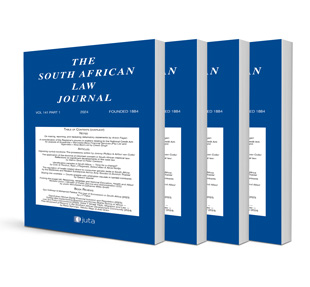Index

Index
Authors Lexinfo
ISSN: 1996-2177
Affiliations: None
Source: South African Law Journal, Volume 135 Number 4, p. iii – xxxv
Abstract
None

ISSN: 1996-2177
Affiliations: None
Source: South African Law Journal, Volume 135 Number 4, p. iii – xxxv
None

ISSN: 1996-2177
Affiliations: University of Cape Town
Source: South African Law Journal, Volume 135 Number 4, p. 805 – 810
None

ISSN: 1996-2177
Affiliations: Judge of the High Court of South Africa
Source: South African Law Journal, Volume 135 Number 4, p. 799 – 804
None

ISSN: 1996-2177
Affiliations: Senior Lecturer, Department of Private Law, University of Johannesburg; Senior Lecturer, Department of Private Law, University of Pretoria
Source: South African Law Journal, Volume 135 Number 4, p. 766 – 798
In Daniels, the Constitutional Court had to decide whether the Extension of Security of Tenure Act 62 of 1997 (‘ESTA’) allows an occupier to bring about improvements on land without the landowner’s permission to make the occupier’s dwelling habitable. The ESTA would be in conflict with an occupier’s rights to tenure security (s 25(6) of the Constitution) and human dignity (s 10 of the Constitution) if it did not provide this right. Madlanga J, for the majority, ruled that this right flows from a natural and proper interpretation of the Act. This finding is unattractive from a single-system-of-law perspective, as it may undermine (instead of promote) the positive characteristics which the Constitution envisions for the whole legal system. We raise two objections against the majority judgment, which stem from the two fundamental principles of subsidiarity. In terms of the first criticism we argue that the majority judgment committed judicial overreach and subverted the rule of law, as it adopted a strained interpretation of s 5(a) of the ESTA by overemphasising the purpose of the Act and abandoning the textual threshold. In the process, the court ascribed vague requirements to s 5(a) which are foreign to the property context within which the ESTA operates, thereby obfuscating the relationship between the ESTA and the common law of unjustified enrichment. Under the second objection, which flows from the first, we argue that the court should instead have developed the common law of unjustified enrichment to come to the occupier’s assistance. This could have been done by expanding the categories of lawful occupiers who are permitted to bring about improvements on land without the landowner’s permission. From a doctrinal perspective the enrichment liability of the owner could then have been limited by the ‘unique relationship’ that exists between the owner and the ESTA occupier and could have been further circumscribed by the ius tollendi, the common-law definition, and the tests for necessary, useful and luxurious improvements. Such a development would have entailed a more principled solution to the case, one which would have promoted greater systemic coherence between the various sources of law applicable to the dispute.

ISSN: 1996-2177
Affiliations: Senior Lecturer, Department of Mercantile Law, University of Pretoria
Source: South African Law Journal, Volume 135 Number 4, p. 737 – 765
Since the Jaftha judgment about 15 years ago, South African mortgage foreclosure law has undergone dramatic changes in the light of the protection afforded to mortgage debtors against the unjustified limitation of their constitutional housing rights. Previously the approach of mortgage enforcement law was to give effect to the proven rights of creditors without much question, but Jaftha changed the approach to one where creative alternatives should be pursued before the home is sold only as a last resort. This contribution focuses on one of the major alternatives to normal foreclosure, namely the debt rearrangement order that can be granted to an over-indebted consumer as part of the National Credit Act’s debt-review process. A particular aim is to link this compulsory debt reorganisation remedy with arguments made by Dyal-Chand with regard to so-called ‘sharing’ remedies based on an interest-outcome model. I therefore illustrate that debt rearrangement can be regarded as a ‘sharing’ remedy that does not solely focus on the parties’ formal title to the mortgaged property, but indeed pays more attention to their respective interests in, and uses of, the property. This perspective can arguably help to uphold debtors’ housing interests while also giving effect to creditors’ economic interests.

ISSN: 1996-2177
Affiliations: Professor of International Law, University of Pretoria
Source: South African Law Journal, Volume 135 Number 4, p. 703 – 736
South Africa has a constitution that has been described, correctly, as an ‘international law-friendly’ constitution. In the landmark decision in S v Makwanyane, the Constitutional Court went to great lengths to show the court’s openness to international law by, inter alia, declaring that the Constitution’s reference to international law included both binding and non-binding international law. Yet the use of, and openness to, international law by South African courts does not tell us about the approach to the identification and interpretation of international law. In other words, the Constitution’s openness to international law presupposes an ascertainment of the content of international law, either through identification or interpretation. But are South African courts able to use techniques, tools and methodology of international law to give content to it? The purpose of this article is to consider this question. It considers this question through an analysis of the decisions of South African courts relying on international law, particularly those of the Constitutional Court. It looks at both old and new cases to make a determination about the extent to which South African courts are faithful to the techniques, tools and methodologies to identify and interpret international law.